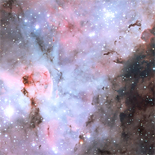Astronomy 301 - Fall 2010
INTRODUCTION TO ASTRONOMY
MWF 9-10 · WEL 3.502 · Unique No. 47635

Carina Nebula (ESO)
Professor
RLM 15.318 · TBA · (512) 471-6446 · email
Courses - Fall '10 | Course Website
Astronomy 301: Unique number 47635
Introduction to Astrononomy. Instructor: John Scalo
Printable syllabus (pdf)
Classroom and time: Welch Hall 3.502, MWF 9-10
Professor: John Scalo
Office: R.L. Moore 15.204
Phone: 471-6446 (office), or 478-2748 (home)
email: scalo@astro.as.utexas.edu
Office hours: M 10:30-12:00, F 3-4 or after any class, or by phone (see below)
My schedule is probably more open than yours, so if those times interfere with classes or work, just tell me a time that would be convenient if you need to talk to me about course material. If you don't have a 10am class, we can also talk outside the classroom (in the foyer) after class. For short questions there is usually no need for you to walk all the way to my office. I welcome phone calls at home--it is an extremely efficient way for us to communicate while a particular question or problem is on your mind. I usually cannot give adequate answers to questions by email, but it is fine if you have non-subject matter comments that do not require a reply--especially welcome are any suggestions or criticisms as the semester progresses (e.g. "You tend to mumble" or "I can't read your handwriting on the board" etc.)
Teaching Assistant: Julie Krugler Holleck
Office: R. L. Moore 17.307
Phone: 471-8414
email: julie@astro.as.utexas.edu
Office hours (tentative): MT 1:30-3:30 (or Th 2:30-4:30 when exam is on Friday)
If office hours require revision, we will send out a group email as well as announce it repeatedly in class. Before each exam we will shift office hours if necessary so that some occur on the day before the exam. Changes like this are ordinarily posted in the "announcements" box at the course web site (see below).
Textbook: Chaisson, E. and McMillan, S. Astronomy Today, 6th Edition Vol. II, Stars and Galaxies.
It is crucial that you purchase the sixth edition, and that you buy volume II of the two-volume version, which comes bundled with an online access code (called "Mastering Astronomy" by the publishers). To compensate for the steep price of the one-volume textbook, I am using only the second volume of the twovolume version, but this will require that students study for one of the exams using the textbook web site--so you do need the "Mastering Astronomy" access. (Details later.) Basically, you purchase an expensive text, but only have to buy half of it.
If you attempt to purchase online, note that there is a 7th edition that was just published, but do not buy the 7th edition, since my notes and assignments and review sheets etc. will be keyed to the page numbers and organization of the 6th edition. The 6th edition of Astronomy Today Volume 2 is $82.40 at amazon.com, with used from $62.00. At that site, or at any site listed in BestBookBuys.com, I see no way to be sure you would be purchasing the second volume of the 2-volume edition we are using, or that it has the access code to the ebook and other online materials. For comparison in case you are tempted, the ISBN of the correct book is 9780321586995. If you want to take a chance with an online purchase, I suggest you immediately buy the new version from the Co-op and return once your online version arrives and you verify that it has the access code. I am using the same textbook for this course in the Spring, so you will be able to sell the textbook to the Co-op at the end of the semester for a sadly small fraction of its value, if you can part with it.
It is important that you have the textbook no later than Friday Aug.27, and that you take time to look through it, to see the layout, level of math, and generally get familiar with what this course is about.
Course web page. https://www.as.utexas.edu/astronomy/education/fall10/scalo/301.html
Make sure you keep this handy. I may try to set up a link through Blackboard, but I will not be keeping lecture slide materials at Blackboard. You could also navigate to the course website through the Astronomy Department web site, https://www.as.utexas.edu/astronomy/education/courses.html by just clicking on AST 301 Scalo. The course website will contain the syllabus; an outline of most class lectures (usually as pdf files); a way for you to easily check your exam scores (link to Blackboard); and a simple way for me to distribute handouts or make slight revisions to the reading assignments or subsections covered on exams. I urge you to check the website often, and keep the url in a handy place.